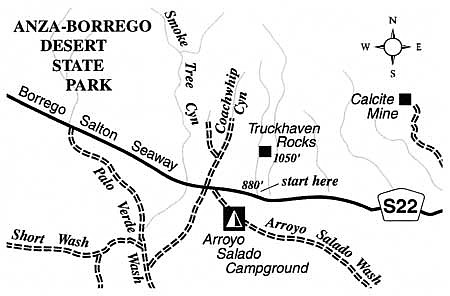 Facebook
Facebook
 X
X
 Instagram
Instagram
 TikTok
TikTok
 Youtube
Youtube
The shorter fall and winter days of low-angle sunshine, clear blue skies, and pleasantly mild temperatures are perfect for exploring any of Anza-Borrego Desert's lowest, hottest, and driest regions. The Truckhaven Rocks, out past Borrego Springs on County Highway S-22 and just shy of the Imperial County line, fit this specification perfectly.
The rocks themselves are somewhat reminiscent of the outcrops of sandstone at Garden of the Gods in Colorado Springs, Colorado. The tilted slabs of beige- and orange-tinted sandstone, which can be plainly seen from the highway, are a favorite haunt of photographers.
Park on the wide shoulder of Highway S-22 at mile 35.5 (this mile marker lies about 17 miles east of Borrego Springs) and head north up the wash that leads toward a point a little east of the Truckhaven Rocks. Climbing out of this wash to reach the outcrops, you'll cross a boulder-strewn plain dotted with spindly ocotillo. Here and there, in areas free of large rocks, are patches of "desert pavement," a surface condition in which small pebbles of roughly uniform size form a flat mosaic. This is a result of fine particles being blown away, leaving the larger particles and pebbles to settle and pack together.
Only three-quarters of a mile of easy walking suffices to take you to the Truckhaven Rocks -- but for adventurous souls, this is just the beginning. Behind (north of) the rocks lies a dissected landscape of narrow ravines that slash deep into layers of coarse sedimentary rock. The sediments were uplifted thousands of feet, and also crumpled and tilted, on the back, so to speak, of the southern Santa Rosa Mountains. This mountain range, and others along the mountain-desert border from Riverside County into Baja California, were squeezed upward by tectonic movements associated with the nearby San Andreas Fault and faults parallel to it. Flash floods, tearing at the uplifted sediments, have shredded the landscape over a period of hundreds of thousands of years, thus creating the fascinating, mazelike topography you have the pleasure of exploring here.
This article contains information about a publicly owned recreation or wilderness area. Trails and pathways are not necessarily marked. Conditions can change rapidly. Hikers should be properly equipped and have safety and navigational skills. The Reader and Jerry Schad assume no responsibility for any adverse experience.


The shorter fall and winter days of low-angle sunshine, clear blue skies, and pleasantly mild temperatures are perfect for exploring any of Anza-Borrego Desert's lowest, hottest, and driest regions. The Truckhaven Rocks, out past Borrego Springs on County Highway S-22 and just shy of the Imperial County line, fit this specification perfectly.
The rocks themselves are somewhat reminiscent of the outcrops of sandstone at Garden of the Gods in Colorado Springs, Colorado. The tilted slabs of beige- and orange-tinted sandstone, which can be plainly seen from the highway, are a favorite haunt of photographers.
Park on the wide shoulder of Highway S-22 at mile 35.5 (this mile marker lies about 17 miles east of Borrego Springs) and head north up the wash that leads toward a point a little east of the Truckhaven Rocks. Climbing out of this wash to reach the outcrops, you'll cross a boulder-strewn plain dotted with spindly ocotillo. Here and there, in areas free of large rocks, are patches of "desert pavement," a surface condition in which small pebbles of roughly uniform size form a flat mosaic. This is a result of fine particles being blown away, leaving the larger particles and pebbles to settle and pack together.
Only three-quarters of a mile of easy walking suffices to take you to the Truckhaven Rocks -- but for adventurous souls, this is just the beginning. Behind (north of) the rocks lies a dissected landscape of narrow ravines that slash deep into layers of coarse sedimentary rock. The sediments were uplifted thousands of feet, and also crumpled and tilted, on the back, so to speak, of the southern Santa Rosa Mountains. This mountain range, and others along the mountain-desert border from Riverside County into Baja California, were squeezed upward by tectonic movements associated with the nearby San Andreas Fault and faults parallel to it. Flash floods, tearing at the uplifted sediments, have shredded the landscape over a period of hundreds of thousands of years, thus creating the fascinating, mazelike topography you have the pleasure of exploring here.
This article contains information about a publicly owned recreation or wilderness area. Trails and pathways are not necessarily marked. Conditions can change rapidly. Hikers should be properly equipped and have safety and navigational skills. The Reader and Jerry Schad assume no responsibility for any adverse experience.
